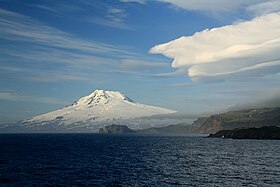Beerenberg
| Beerenberg | |
|---|---|

Beerenberg, July 2011
|
|
| Highest point | |
| Elevation | 2,277 m (7,470 ft) |
| Prominence | 2,277 m (7,470 ft) |
| Listing | Ultra |
| Coordinates | 71°4′36″N 8°9′52″W / 71.07667°N 8.16444°WCoordinates: 71°4′36″N 8°9′52″W / 71.07667°N 8.16444°W |
| Geography | |
| Geology | |
| Mountain type | Stratovolcano |
| Last eruption | January 1985 |
| Climbing | |
| First ascent | 1921 Wordie, Mercanton and Lethbridge |
Beerenberg is a 2,277 m (7,470 ft) stratovolcano which forms the northeastern end of the Norwegian island of Jan Mayen. It is the world's northernmost subaerial active volcano. The volcano is topped by a mostly ice-filled crater about 1 km (0.6 mi) wide, with numerous peaks along its rim including the highest summit, Haakon VII Toppen, on its western side.
The upper slopes of the volcano are largely ice-covered, with several major glaciers including five which reach the sea. The longest of the glaciers is the Weyprecht Glacier, which flows from the summit crater via a breach through the northwestern portion of the crater rim, and extends about 6 km (4 mi) down to the sea.
Beerenberg is composed primarily of basaltic lava flows with minor amounts of tephra. Numerous cinder cones have been formed along flank fissures.
Its most recent eruptions took place in 1985 and 1970 both of which were flank eruptions from fissures on the northeast side of the mountain. Other eruptions with historical records occurred in 1732, 1818, and 1851.
Its name means "Bear Mountain" in Dutch, and it takes its name from the polar bears seen there by Dutch whalers in the early 17th century.
...
Wikipedia

